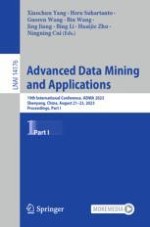2023 | Buch
Advanced Data Mining and Applications
19th International Conference, ADMA 2023, Shenyang, China, August 21–23, 2023, Proceedings, Part I
herausgegeben von: Xiaochun Yang, Heru Suhartanto, Guoren Wang, Bin Wang, Jing Jiang, Bing Li, Huaijie Zhu, Ningning Cui
Verlag: Springer Nature Switzerland
Buchreihe : Lecture Notes in Computer Science
